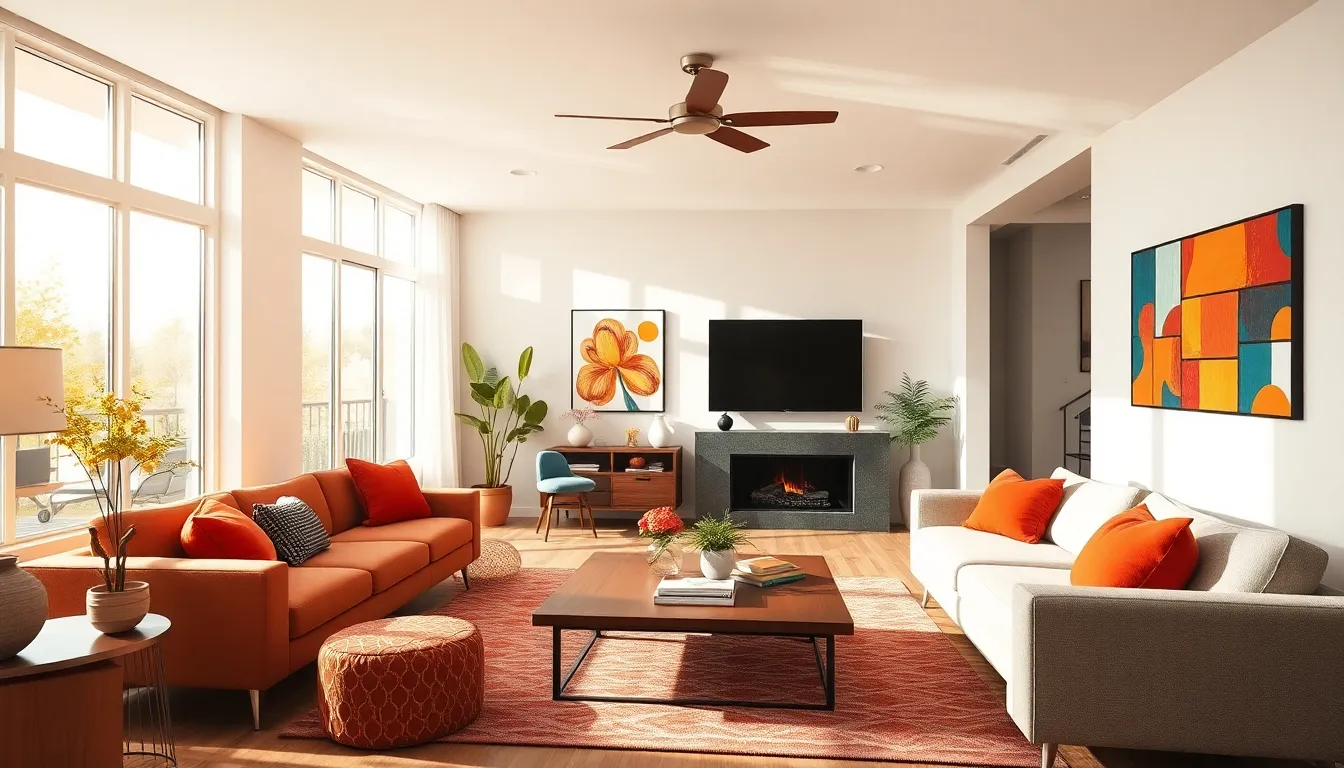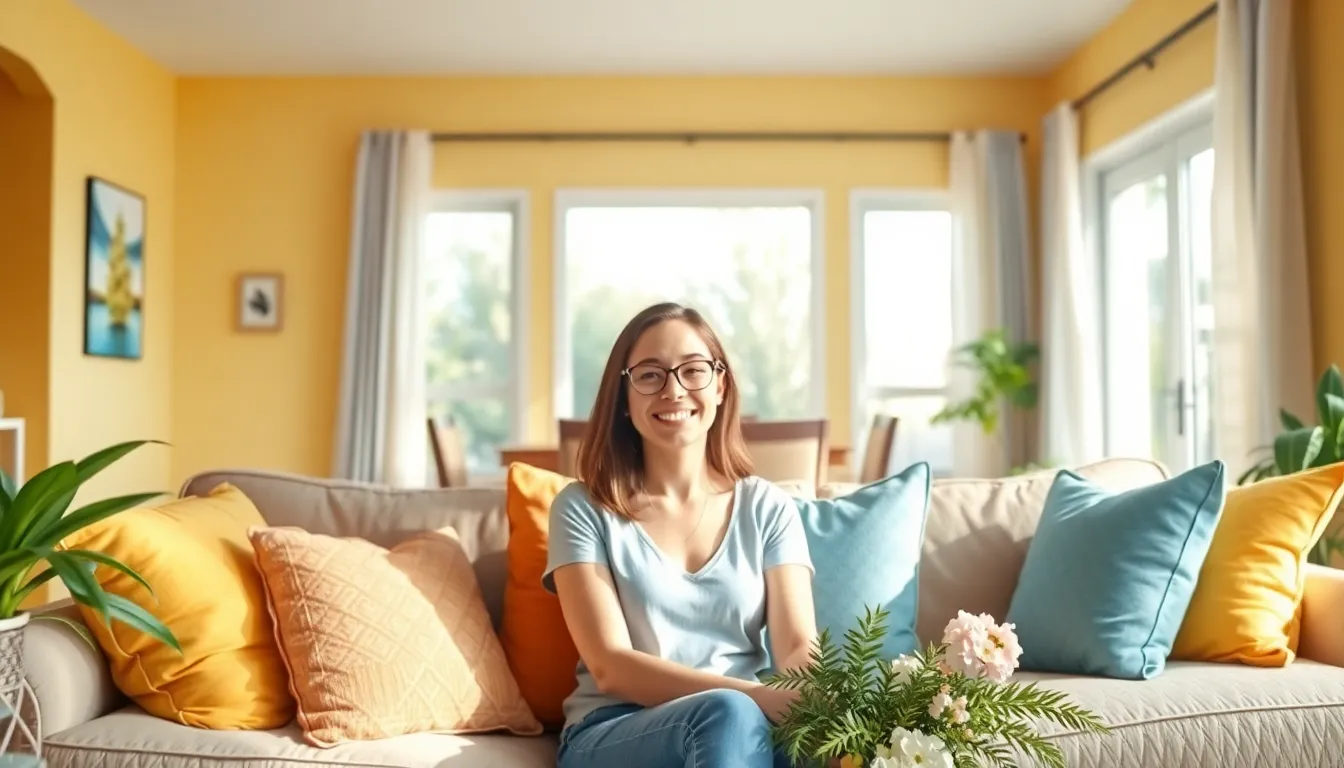Colors play a powerful role in shaping emotions and influencing behavior, especially in the comfort of one’s home. Each hue carries its own psychological weight, impacting moods and feelings in subtle yet significant ways. Understanding color psychology can help homeowners create spaces that foster relaxation, creativity, or even productivity.
From calming blues to energizing yellows, the right color palette can transform an environment, making it feel more inviting or stimulating. As people look to enhance their living spaces, exploring how colors affect their daily lives becomes essential. This article delves into the fascinating world of color psychology, offering insights on how to choose the perfect shades for every room in the house.
Table of Contents
ToggleUnderstanding Color Psychology
Color psychology examines how colors affect emotions and behaviors. This field plays a vital role in creating environments that enhance lifestyles within homes.
Definition of Color Psychology
Color psychology studies the emotional and psychological effects of colors. Each hue encompasses specific meanings and associations that can influence moods. For example, blue often evokes tranquility, while red signifies passion and energy. Understanding these associations allows individuals to make informed decisions when selecting colors for living spaces.
Importance in Home Décor
Color selection significantly impacts home décor and the overall atmosphere of a space. Thoughtfully chosen colors can foster certain feelings and enhance functionality.
- Calmness: Soft blues and greens promote relaxation, ideal for bedrooms and bathrooms.
- Creativity: Vibrant yellows and oranges stimulate creativity, suitable for workspaces or art studios.
- Focus: Neutral tones foster focus and clarity, making them advantageous for home offices.
- Warmth: Earthy tones like browns and terracotta create a cozy ambiance, perfect for living rooms.
Using appropriate colors aligns the home environment with personal preferences and desired emotional responses.
The Impact of Color on Mood

Colors significantly influence emotions and behaviors, shaping the atmosphere within home environments. Understanding these effects helps homeowners create spaces that support their desired mood.
Warm Colors and Their Effects
Warm colors, including reds, oranges, and yellows, evoke feelings of energy and warmth. These hues tend to stimulate conversation and foster a sense of excitement. Red, for instance, can elevate heart rates and boost energy levels, making it ideal for social spaces like dining rooms or living areas. Orange promotes enthusiasm and creativity, making it a favorable choice for kitchens or playrooms. Yellow, associated with positivity and happiness, brightens areas like home offices or creative studios, enhancing productivity.
Cool Colors and Their Effects
Cool colors, such as blues, greens, and purples, promote tranquility and calm. Blue, linked to serenity and relaxation, works well in bedrooms and bathrooms, creating a serene environment. Green, representing nature, can reduce stress and increase focus, making it suitable for home offices or study areas. Soft purples, like lavender, inspire creativity while providing a calming effect, ideal for craft rooms or reading nooks. By strategically using cool colors, individuals can foster peace and balance within their living spaces.
Choosing Colors for Different Rooms
Choosing colors for different rooms significantly influences the overall atmosphere of a home. Selecting the right hues can elevate emotional responses and enhance functionality.
Living Room Color Ideas
Living rooms serve as social hubs where relaxation and interaction occur. Consider warm hues such as soft yellows or rich terracotta for an inviting ambiance. These colors foster conversation and warmth. Alternatively, incorporate cool blues or earthy greens to promote calmness and balance, fostering space for relaxation. Combining neutral tones with vibrant accents creates visual interest and harmony.
Bedroom Color Ideas
Bedrooms require colors that facilitate restful environments. Soft pastels such as lavender or light blue promote tranquility, encouraging better sleep. Darker shades like deep blue or forest green can add a touch of intimacy and serenity. To maintain a cozy atmosphere, consider warm neutrals that create a soothing backdrop while allowing for personal expression through textiles and decor.
Kitchen Color Ideas
Kitchens benefit from energizing and uplifting colors, enhancing creativity and appetite. Bright whites or soft yellows can open up the space, making it feel larger and lighter. Warm reds or oranges can stimulate energy, suitable for cooking and socializing. Incorporating splashy colors on cabinetry or appliances adds personality and excitement, creating an inspiring culinary environment.
Cultural Perspectives on Color
Cultural backgrounds significantly shape color perceptions and associations. Understanding these perspectives can inform effective color choices for home environments.
Western Color Associations
In Western cultures, color meanings often derive from historical, psychological, and social contexts. Key associations include:
- Red: Symbolizes love, passion, and danger. Commonly used in dining areas to stimulate appetite and conversation.
- Blue: Represents calmness, trust, and stability. Frequently seen in bedrooms to encourage relaxation and sleep.
- Yellow: Signifies happiness, optimism, and creativity. Often used in kitchens or playrooms to energize and uplift.
- Green: Associated with nature, growth, and tranquility. Ideal for living spaces to promote a soothing atmosphere.
- Black: Evokes sophistication, elegance, and formality. Often used in accents for a modern touch or in creating a dramatic look.
- White: Conveys purity, cleanliness, and simplicity. Commonly applied in minimalist designs to enhance brightness and openness.
Eastern Color Associations
Eastern cultures offer distinct color associations shaped by traditions and beliefs. Important associations include:
- Red: Symbolizes luck, happiness, and celebration. Widely used in homes during festivities for inviting positive energy.
- Yellow: Represents power, wealth, and fertility. Frequently seen in interiors to denote prosperity and stability.
- Green: Associated with harmony, growth, and health. Used in living spaces to promote balance and revitalization.
- Blue: Evokes tranquility and protection. Often chosen for bedrooms to create a serene resting environment.
- White: Widely recognized as a symbol of mourning and purity. Typically utilized in traditional ceremonies rather than daily decor.
- Black: Represents darkness and mystery. Generally avoided in prominent spaces due to negative connotations.
By acknowledging cultural perspectives on color, homeowners can make choices that resonate with personal values and enhance their living environments.
Tips for Implementing Color Psychology in Home
Implementing color psychology in home design enhances emotional experiences and creates inviting spaces. Homeowners can use specific strategies for achieving the desired atmosphere in each room.
Using Accent Walls
Using accent walls creates focal points and adds depth to a room. Homeowners can choose a bold color that contrasts with surrounding walls to draw attention, enhancing the room’s personality. For example, a vibrant red or deep blue can energize a living space. In bedrooms, softer shades like teal can promote relaxation while still serving as a statement feature. Selecting a color that aligns with the room’s purpose maximizes its emotional impact, ensuring harmony between aesthetics and feelings.
Choosing the Right Shades
Choosing the right shades is crucial for maximizing color psychology’s benefits. Homeowners should consider light versus dark tones; lighter shades create an airy, spacious feel, while darker shades provide intimacy and warmth. For example, creamy whites and soft pastels can promote tranquility in a bedroom, while bold tones can energize a kitchen. It’s beneficial to test colors in natural light, as this changes their appearance and affects mood. Utilizing a color wheel can aid in selecting harmonious combinations that evoke the desired emotional responses, creating balanced and inviting spaces throughout the home.
Understanding color psychology is essential for creating a harmonious home environment. By selecting the right hues, individuals can significantly influence their emotions and enhance their overall well-being. Whether aiming for relaxation in a bedroom or energy in a kitchen, color choices play a pivotal role in shaping experiences.
Cultural perceptions further enrich the way colors are interpreted, making it crucial to consider personal backgrounds when designing spaces. With thoughtful application of color psychology, homeowners can craft inviting atmospheres that resonate with their unique preferences. Ultimately, the right colors not only beautify a space but also foster a sense of peace and happiness in everyday life.


